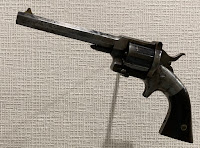 |
| Gen. Logan and Capt. DeGress rush toward captured cannons (Atlanta History Center) |
While the 370-foot circumference painting has dozens of small scenes and thousands of figures, the house is clearly the focal point of
the battle – misinterpreted for years by its Southern promoters as showing a
Rebel victory. Instead, something big is about to happen that will ensure this day
will, in fact, see a Federal triumph.
Galloping furiously to the rescue, hat in hand, is Maj. Gen. John A. “Black Jack” Logan, head of the Army of the Tennessee. Behind him
is Capt. Francis DeGress, whose artillery battery had been overrun shortly
before.
 |
| Rebel breakthrough at Troup Hurt house (Picket photo) |
DeGress, already a respected
veteran, is about to become a folk hero to the Northern cause. He retakes the
four 20-pounder Parrott guns and turns them on the retreating Confederates.
“He is an example of the sort of mid-level
officer who was a natural leader, on whom the troops really came to depend. On
whom the battle depended,” said Jones, adding it is the privates, sergeants,
lieutenants and captains who are controlling the battle.
Exhibits at the AHC include several DeGress artifacts, including a saber he likely carried that day, a Pond revolver he purchased a few months before the battle, a 15th Corps badge and a bit that was used by one of the battery’s horses during the fighting. They were donated by family members. The AHC has papers related to DeGress at its Kenan Research Center.
The German-born artilleryman, commander of
Company H, 1st Illinois Light Artillery, was a veteran of several
campaigns by the time he arrived in Atlanta. The 23-year-old’s battery was
deployed in a vulnerable part of the Union line, east of the city and near a
railroad line. (Sketch of DeGress, left, appeared in Harper's Weekly)
At 4 p.m. on July 22, the battery was firing
canister as fast as it could. The determined Confederates continued to push forward and were about to be upon them.
DeGress knew the horses could not pull back
the guns in time, Jones said, and he had two guns spiked. The captain and Sgt.
Peter Wyman stayed with the other two weapons, firing double canister. They eventually
had to flee; Wyman was killed while DeGress fled back to the collapsed Federal
line.
Fast-forward to the scene depicted in the
cyclorama: Logan rallying his troops and rushing toward the breach. DeGress
soon regains possession of the battery and gets back into the action.
 |
| Bit that belonged to one of the battery horses (Picket photo) |
“You are seeing in the painting the
Confederates are killing the horses because they are about to be overrun,” says
Jones. But there’s a chance that DeGress ordered some of them be shot before
his retreat. It was not unusual occurrence, because armies did not want their
own guns used against them.
“Perhaps the mostly skillfully rendered figures
in the painting are the horses,” says Jones. “The closest the artists got to
real horror, they are showing them writhing in agony.”
Among the German and Austrian artists who
created the cyclorama in 1886 was Albert Richter. He painted the horses based
on sketches made at a Milwaukee slaughterhouse, where he apparently paid to use
dying horses as models.
 |
| Depiction of the killing of battery horses (Picket photo) |
DeGress’ battery took part in the March to the
Sea after Atlanta and the campaigns in South Carolina and North Carolina, and
was present at the surrender of Confederate Gen. Joseph E. Johnston near Durham
in April 1865.
After the war, the soldier went into business
in Mexico, with a firearms company among his ventures. He died in 1883 – three
years before the cyclorama was painted -- in Mexico City and is buried there.
 |
| DeGress' revolver (Picket photo) |
“One measure of this regard is how quickly he was
able to reconstitute his battery (H, 1st Illinois) after his guns were reclaimed on 22 July 1864,” says Crawford. “This is a
testament to his own leadership and to how
readily the other artillery batteries provided horses, harnesses, limbers, caissons and other equipment.”
The cyclorama shows the moment Alabama and
South Carolina troops in Brig. Gen. Arthur Manigault’s brigade punctured the
Union line. The AHC has the saber Manigault carried that day.
The Troup Hurt house is long gone. A church
was built on the site, and now that structure is a private residence.
 |
| Troup Hurt house was where this home was erected (Picket photo) |
By evening, Confederate troops under Gen. John Bell Hood were repulsed with heavy losses. Fighting continued in and around Atlanta for several weeks, until the Rebels evacuated and the city fell.
Among the clashes was the little-known battle at Utoy Creek.
"The War in Our Backyards": See the AJC's 2014 comprehensive interactive on the Atlanta Campaign
 |
| DeGress swords, saber at top believed used in battle (Picket photo) |

No comments:
Post a Comment